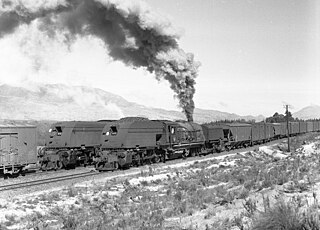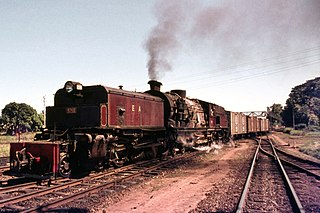
A Garratt locomotive is a type of articulated steam locomotive invented by British engineer Herbert William Garratt that is articulated into three parts. Its boiler, firebox, and cab are mounted on a centre frame or "bridge". The two other parts, one at each end, have a pivot to support the central frame; they consist of a steam engine unit – with driving wheels, trailing wheels, valve gear, and cylinders, and above it, fuel and/or water storage.

The Tasmanian Government Railways K class was a class of 0-4-0+0-4-0 Garratt locomotives operated by the Tasmanian Government Railways from 1909 – the first Garratt locomotives built.

Under the Whyte notation for the classification of steam locomotives by wheel arrangement, 2-6-2+2-6-2 is an articulated locomotive using a pair of 2-6-2 power units back to back, with the boiler and cab suspended between them. The 2-6-2 wheel arrangement has a single pair of leading wheels in a leading truck, followed by three coupled pairs of driving wheels and a pair of trailing wheels in a trailing truck.

Under the Whyte notation for the classification of steam locomotives by wheel arrangement, the 4-6-4+4-6-4 is a Garratt articulated locomotive. The wheel arrangement is effectively two 4-6-4 locomotives operating back to back, with the boiler and cab suspended between the two engine units. Each engine unit has two pairs of leading wheels in a leading bogie, followed by three coupled pairs of driving wheels and two pairs of trailing wheels in a trailing bogie.

The WAGR V class was the last class of steam locomotive to enter service with the Western Australian Government Railways (WAGR). The class was part of the post war regeneration plan for the WAGR, intended for the heavy coal traffic between the Collie coal fields and Perth.

The South African Railways Class 25NC 4-8-4 of 1953 was a class of steam locomotives built between 1953 and 1955 for the South African Railways (SAR). The Class 25NC was the non-condensing version of the Class 25 condensing locomotive, of which ninety were placed in service at the same time. Between 1973 and 1980, all but three of the condensing locomotives were converted to non-condensing and also designated Class 25NC.

The South African Railways Class 19D 4-8-2 of 1937 was a steam locomotive.

The South African Railways Class 14 4-8-2 of 1913 was a steam locomotive.
The South African Railways Class FD 2-6-2+2-6-2 of 1926 was an articulated steam locomotive.

The South African Railways Class GEA 4-8-2+2-8-4 of 1946 was an articulated steam locomotive.

The South African Railways Class GM 4-8-2+2-8-4 of 1938 was an articulated steam locomotive.

The South African Railways Class GMA 4-8-2+2-8-4 of 1954 is an articulated steam locomotive.

The South African Railways Class GO 4-8-2+2-8-4 of 1954 was an articulated steam locomotive.

The Rhodesia Railways 15th class, was the second-largest class of Garratt locomotives, with 74 locomotives built. Only the Class GMA/GMAM of the South African Railways was more numerous at 120 locomotives.

The Rhodesia Railways 20th class, later Zambia Railways and National Railways of Zimbabwe 20th classes, were among the largest and most powerful steam locomotives in the southern hemisphere.

The KUR EC3 class, later known as the EAR 57 class, was a class of 1,000 mm gauge 4-8-4+4-8-4 Garratt-type articulated steam locomotives. The twelve members of the class were built by Beyer, Peacock & Co. in Manchester, England, for the Kenya-Uganda Railway (KUR). They entered service between 1939 and 1941, and were later operated by the KUR's successor, the East African Railways (EAR).

The KUR EC2 class, later known as the EAR 52 class, was a class of 1,000 mm gauge 4-8-2+2-8-4 Garratt-type articulated steam locomotives operated by the Kenya-Uganda Railway (KUR) and the East African Railways (EAR).

The KUR EC4 class, later known as the EAR 54 class, was a class of 1,000 mm gauge 4-8-2+2-8-4 Garratt-type articulated steam locomotives developed under and for use in wartime conditions.

The EAR 56 class was a class of 1,000 mm gauge 4-8-2+2-8-4 Garratt-type articulated steam locomotives built by Beyer, Peacock & Co. in Gorton, Manchester, England, in 1949. The six members of the class were ordered by the Kenya-Uganda Railway (KUR) immediately after World War II, and were a slightly modified version of the KUR's existing EC5 class.

The KUR EC5 class was a class of 1,000 mm gauge 4-8-2+2-8-4 Garratt-type articulated steam locomotives built during the latter stages of World War II by Beyer, Peacock & Co. in Gorton, Manchester, England, for the War Department of the United Kingdom. The two members of the class entered service on the Kenya-Uganda Railway (KUR) in 1945. They were part of a batch of 20 locomotives, the rest of which were sent to either India or Burma.



















